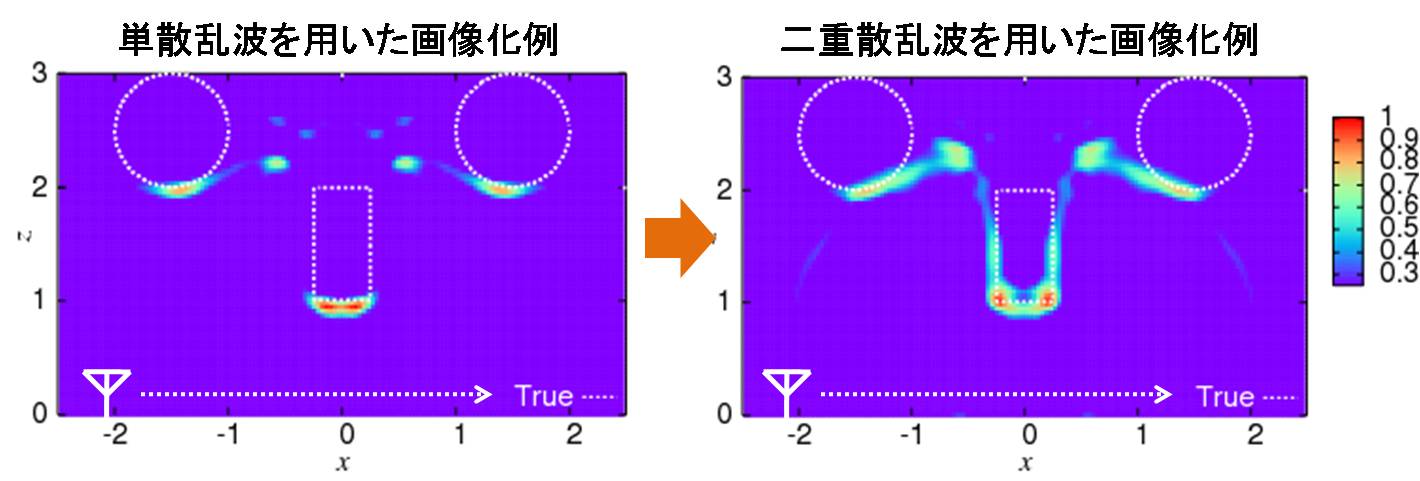Shadow Area Imaging Method Using Multiple Scattered Waves
Radar is capable of precise spatial measurement (e.g., rescue robots at disaster sites) in poor visibility and invisible areas (darkness, dense smoke, dense fog, etc.),
and has promising applications in indoor robots and security systems. However, in indoor environments, multiple scattered waves from walls and other objects cause false images in radar images.
In this research, we propose a technique to image the sides and back of a target, which cannot be seen with a single scattered wave, by actively utilizing the multiple scattered waves, which cause false images, for imaging. By applying this technique, target shape estimation becomes possible even when the observation area is limited, such as in a room.
The left figure in Figure 1 shows an example of imaging using only a single scattered wave, and it can be seen that the rectangular side cannot be reproduced. As long as only a single scattered wave is used in the element scanning area shown in Figure 1, it is inevitable that the side area will become a shadow area. In contrast, the figure on the right shows the use of double scattered waves for imaging.
Since the double scattered wave passes through the circular and rectangular sides and is received by the element, the same sides can be reproduced by imaging the double scattered wave.
Figure 2 shows an example of 3D estimation by combining a super wavelength resolution algorithm and multiple scattered wave imaging. Using this technique, the shadow area of a target can be estimated in a few seconds and with ultra-long wavelength accuracy, instead of several hours using the SAR-based method. These research results exceed the limits of conventional radar image reproduction ranges, and have attracted attention not only from radio waves but also from other wave sensing fields.
Future Prospects:
Based on these theories, this research theme is conducting world-leading research by setting challenging problems such as imaging moving targets whose motion and shape are completely unknown, and under conditions where a large observation area is not available.


Shouhei Kidera and Tetsuo Kirimoto,
" Fast and Shadow Region 3-dimensional Imaging Algorithm with Range Derivative of Doubly Scattered Signals for UWB Radars", ,
IEEE Trans. on Antennas and Propagation, vol.60, 2012 (in press). Shouhei Kidera, Takuya Sakamoto and Toru Sato,
"Extended Imaging Algorithm Based on Aperture Synthesis with Double Scattered Waves for UWB Radars", ,
IEEE Trans. on Geoscience and Remote Sensing, (in press). Ken Akune, Shouhei Kidera, Tetsuo Kirimoto,
"Acceleration for Shadow Region Imaging Algorithm with Multiple Scattered Waves for UWB Radars" ,
IEICE Trans. Commun. (Letter), vol. E94-B, No. 9, pp.2696--2699, Sep, 2011.
In this research, we propose a technique to image the sides and back of a target, which cannot be seen with a single scattered wave, by actively utilizing the multiple scattered waves, which cause false images, for imaging. By applying this technique, target shape estimation becomes possible even when the observation area is limited, such as in a room.
The left figure in Figure 1 shows an example of imaging using only a single scattered wave, and it can be seen that the rectangular side cannot be reproduced. As long as only a single scattered wave is used in the element scanning area shown in Figure 1, it is inevitable that the side area will become a shadow area. In contrast, the figure on the right shows the use of double scattered waves for imaging.
Since the double scattered wave passes through the circular and rectangular sides and is received by the element, the same sides can be reproduced by imaging the double scattered wave.
Figure 2 shows an example of 3D estimation by combining a super wavelength resolution algorithm and multiple scattered wave imaging. Using this technique, the shadow area of a target can be estimated in a few seconds and with ultra-long wavelength accuracy, instead of several hours using the SAR-based method. These research results exceed the limits of conventional radar image reproduction ranges, and have attracted attention not only from radio waves but also from other wave sensing fields.
Future Prospects:
Based on these theories, this research theme is conducting world-leading research by setting challenging problems such as imaging moving targets whose motion and shape are completely unknown, and under conditions where a large observation area is not available.
Figure 1: Imaging example (left: single-scattered wave composite, right: double-scattered wave composite)

Figure 2: Example of 3D imaging (left: true target boundary, right: estimated image by extended RPM method)

References
" Fast and Shadow Region 3-dimensional Imaging Algorithm with Range Derivative of Doubly Scattered Signals for UWB Radars", ,
IEEE Trans. on Antennas and Propagation, vol.60, 2012 (in press).
"Extended Imaging Algorithm Based on Aperture Synthesis with Double Scattered Waves for UWB Radars", ,
IEEE Trans. on Geoscience and Remote Sensing, (in press).
"Acceleration for Shadow Region Imaging Algorithm with Multiple Scattered Waves for UWB Radars" ,
IEICE Trans. Commun. (Letter), vol. E94-B, No. 9, pp.2696--2699, Sep, 2011.
